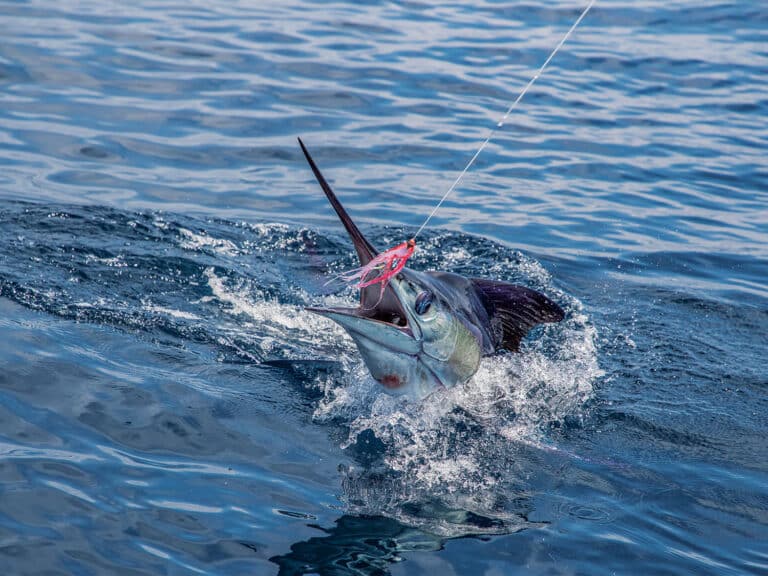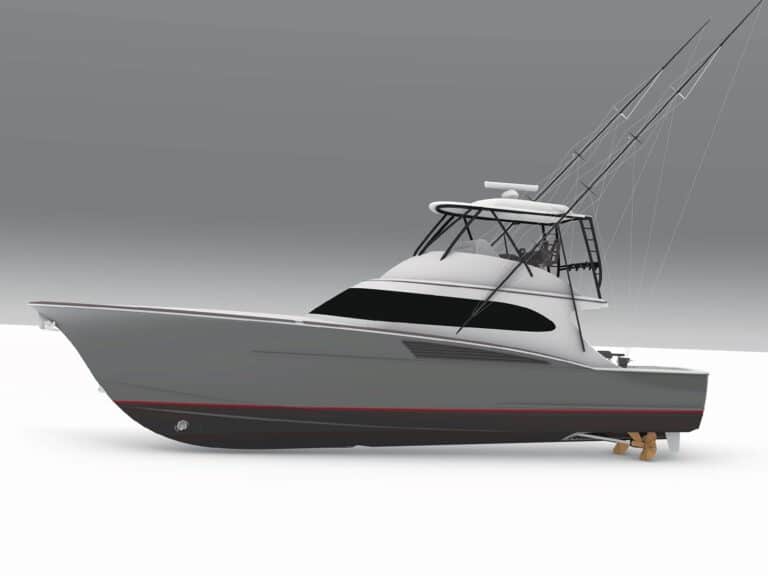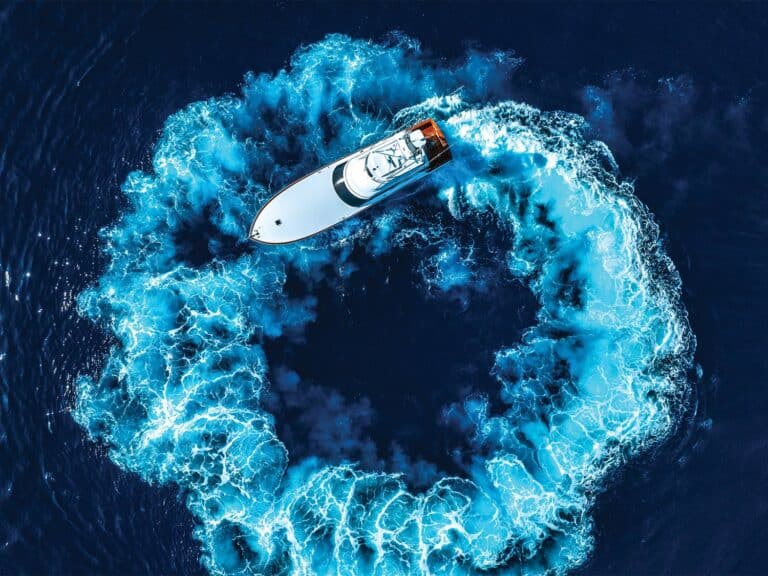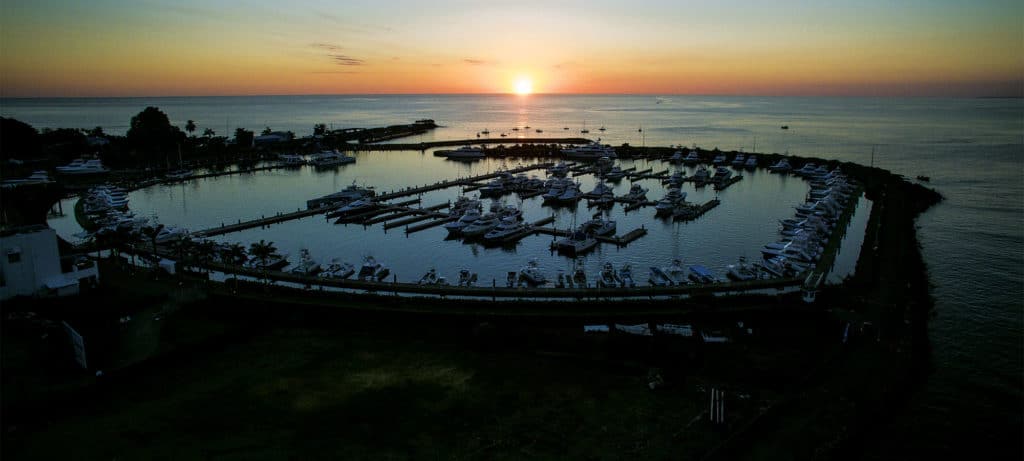
Perched on a narrow strip of rugged Pacific coast, snugged between the mountains and the sea, Quepos, Costa Rica, has always produced great fishing, not to mention generations of top-flight Costa Rican captains and mates. And with the world-class Marina Pez Vela fully online, Quepos is poised to take its rightful place among the world’s top destinations.
I got the call from Brent Brauner, the global brand manager for Columbia Sportswear’s PFG line of performance fishing gear. He wanted to field-test some new warm-weather clothing and capture some blue marlin action on camera. The only catch was that the trip had to take place before the end of 2018. Over the next few weeks we narrowed down the choices, finally deciding on Costa Rica.
With the seamounts producing the most reliable blue marlin fishing on the planet, we elected on a sort of combination expedition: two days offshore with a bonus day trip to target tuna on the spinner dolphins, sailfish on baitballs or anything else we could find. With its calm seas and a great transitional bite, we chose Quepos as the place to be in mid-December.
Brauner brought Columbia’s ace cameraman Joshua VanPatter, while I tapped Marlin Senior Editor Jen Copeland to round out our team. We needed a vessel large enough to support not just our crew but a medium-sized mountain of camera gear, so I called up Ken and Amanda Cofer at Tranquilo Charters. Fortunately, their 57-foot Spencer was available. After a recent refit in Florida, the boat was perfect for our needs: The staterooms had been converted to bunks for added sleeping and gear storage, and the addition of a Seakeeper gyro meant a rock-stable platform. The plan was to arrive in Costa Rica, head for Quepos and jump straight aboard, steam all night for the distant seamounts around 100 miles offshore, fish the first day, spend the night, fish most of the next day, return to port, and day-trip out of Marina Pez Vela for our final day.
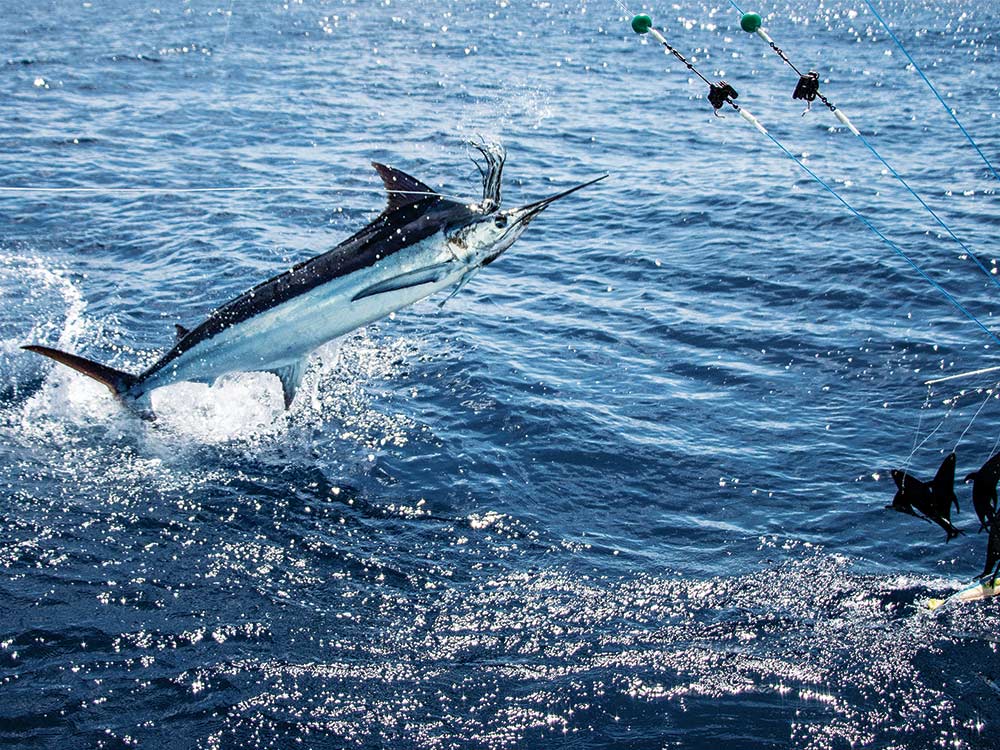
The Transformation
The first time I fished out of Quepos, there was no marina, or even the thought of one. Charter boats used anchor-ball moorings in the lee of the protected coastline, and fishermen arrived and departed by way of an ancient concrete quay that also served as a commercial dock. Despite the rustic conditions, the fishing has always been outstanding pretty much all year round.
Packs of sailfish arrive to reinforce the local resident fish around Thanksgiving and stay well into April most years. There are also enough blue marlin around that you have a very good shot at raising at least one, especially earlier in the season, and multiple-marlin days are a definite possibility. Blacks and stripes are not considered a common catch but it’s certainly not unusual to add one of either species to the tally, either.
Fast forward roughly two decades and my, how things have changed. Marina Pez Vela now sports a modern cofferdam system that means a safe, calm basin year-round. It has 195 slips in operation with the ability to add an additional 100 slips in the future, all with a safe operating depth of 14 feet for vessels up to 200 feet in length. The fuel dock has high-speed fuel delivery, and each slip has fiber-optic internet and digital cable.
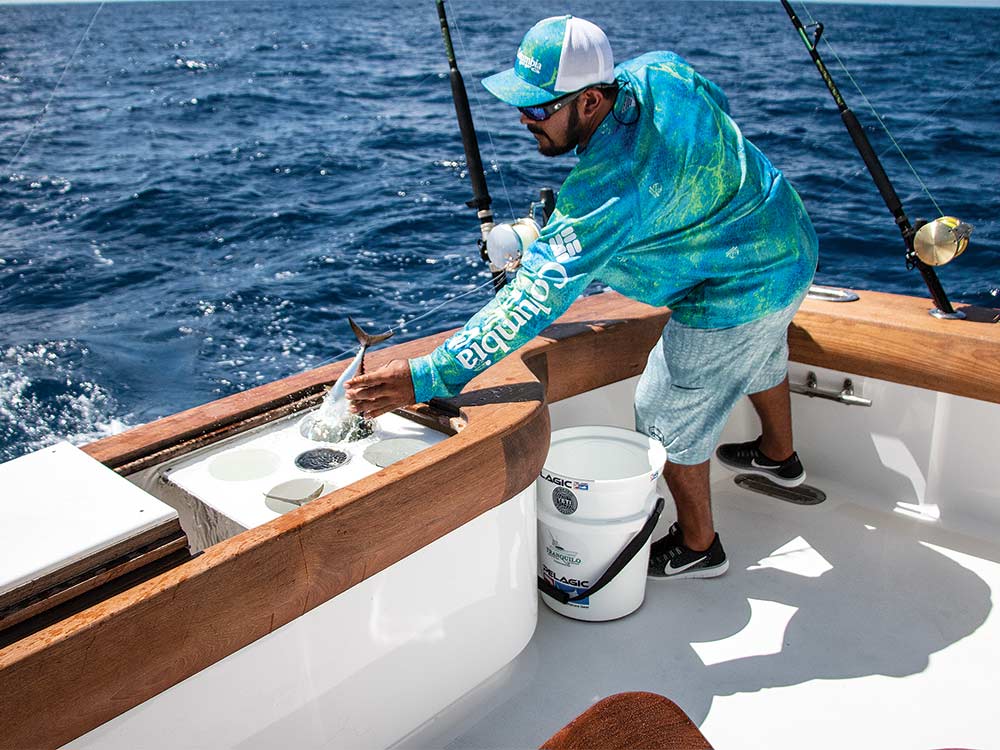
Perhaps one of the most important yet often overlooked features is the boatyard. Before the development of Marina Pez Vela, the options to haul out a sport-fisher in this region usually meant a trip up to Puntarenas and the commercial yard there. Now, Quepos is home to Costa Rica’s first 200-ton Travelift. The full-service facility can handle just about any maintenance needs, from routine service to full refits. There also is a dry stack with a forklift for smaller vessels up to 38 feet in length.
On the upland side, Marina Pez Vela is home to six restaurants including the famed Runaway Grill, as well as a provisioning center and supermarket. There are also numerous retail stores, tour operators, car-rental agencies, Promerica Bank, a medical center and more, plus storage bodegas and even a captain’s lounge with private conference center and work stations. The entire operation is first-class and on par with any high-end marina in the world, yet it feels at-home comfortable.
I asked Marina Pez Vela’s sales director, Scott Cutter, for his thoughts on the project.
“We’re seeing continued expansion over the next five or six years,” he says. “We are also committed to the boat owners and anglers as the key to the success of the project, which is why we’ve invested heavily in the conditions of the docks and things like providing high-speed internet to each slip. This is a community marina, and the original vision — amazing fishing, warm-hearted people and a strong connection to the land and the sea — continues.”
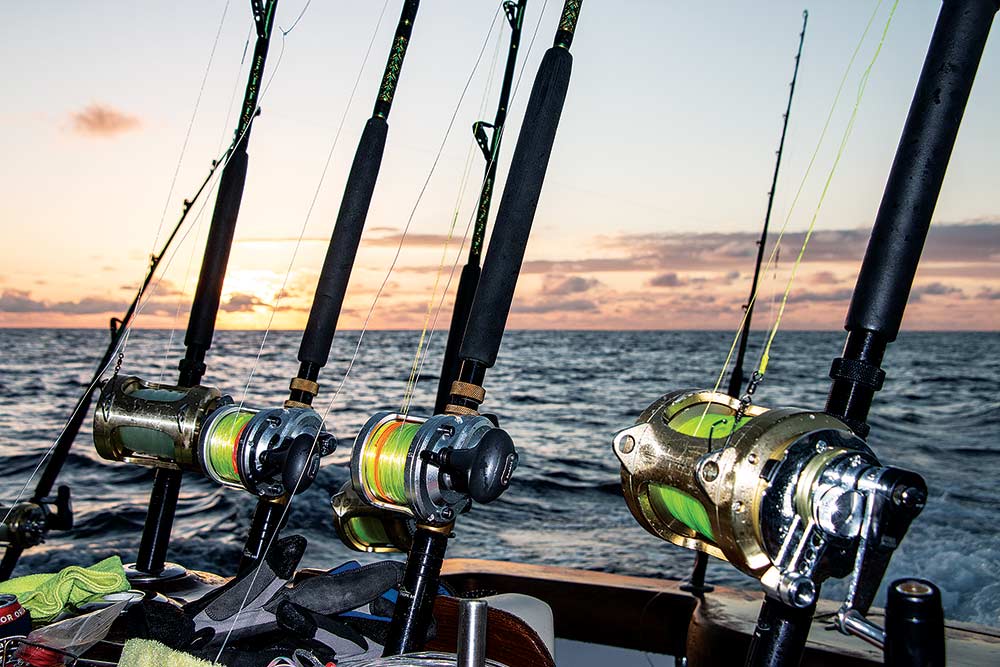
The concept of a community marina was an intriguing one. Rather than be walled off in a private enclave, Marina Pez Vela is right on the main road in Quepos and is open and inviting to visitors and locals alike. Friday nights are free movie nights with free popcorn, where everyone gathers to watch movies under the stars on a big-screen projection setup, and the Bright Lights Christmas boat parade was overflowing with people. Marina staffers dress up like Santa Claus and pass out presents to the kids. It’s what Cutter calls “good human friction” — but it also creates a sense of connectivity to the local community that makes it authentic. It’s also a culture that nurtures the next generation of captains and mates.
See More Costa Rica Fishing here.
Heading Offshore
It is roughly a two-and-a-half-hour ride to Quepos from the Costa Rican capital of San Jose. We stopped about halfway down for lunch and then again to check out the giant saltwater crocodiles hanging out on the banks of the Tarcoles River. We arrived in Quepos in time to meet the Cofers at the Runaway Grill for a cocktail before departure; Capt. Roger Muñoz and first mate Daniel Arrieta secured all the camera gear and we were underway around 8 p.m.
Fishing on the seamounts begins at first light well before dawn, and continues past dusk, basically until you can’t see the baits any longer. We began by trolling a spread of four lures on 50s to scout the area at a faster pace. It wasn’t long before we had our first knockdown — but the hooks failed to find purchase, one of the small frustrations of lure fishing that comes with the territory.
Not red-hot by Costa Rica standards but four blues in a single day is damn good fishing anywhere else in the world.
We did catch our first blue around midmorning on a lure, then transitioned to live-baiting for a bit, then back to the lures. By the end of the first day we had released four blue marlin and had seen or jumped off a few more. Not red-hot by Costa Rica standards but four blues in a single day is damn good fishing anywhere else in the world. After a hot shower, a few rum drinks and an outstanding steak dinner, not to mention more than a few fish stories, it was time to hit the bunks.
The next day, Muñoz chose to run and gun among several locations looking for the mother lode. We released a blue in the morning but never found a hot spot, so we picked up and ran home in the afternoon, fishing for about two hours on one of Muñoz’ favorite spots 45 miles off Quepos. Right away the conditions looked better: There were bait and birds, and the first bite was a 30-pound dorado. A little while later we raised one blue and then another but unfortunately failed to connect on either fish. As we got ready to pack it in for the day, I asked Muñoz what he wanted to do the following morning. The reply was an easy one: Come right back here!
Offshore Bonanza
Our last fishing day was a standard day trip out of Marina Pez Vela. First up: tuna under birds and spinner dolphin. The ocean was alive with these mammals, showing off their wild aerial antics and swimming within a few feet of the boat as we trolled past. It’s one of those National Geographic moments offshore, and for guys like Brauner and VanPatter who had never experienced this before, it is awe-inspiring. Brauner even broke out the fly rod, casting at busting tuna from Tranquilo‘s broad Carolina bow.
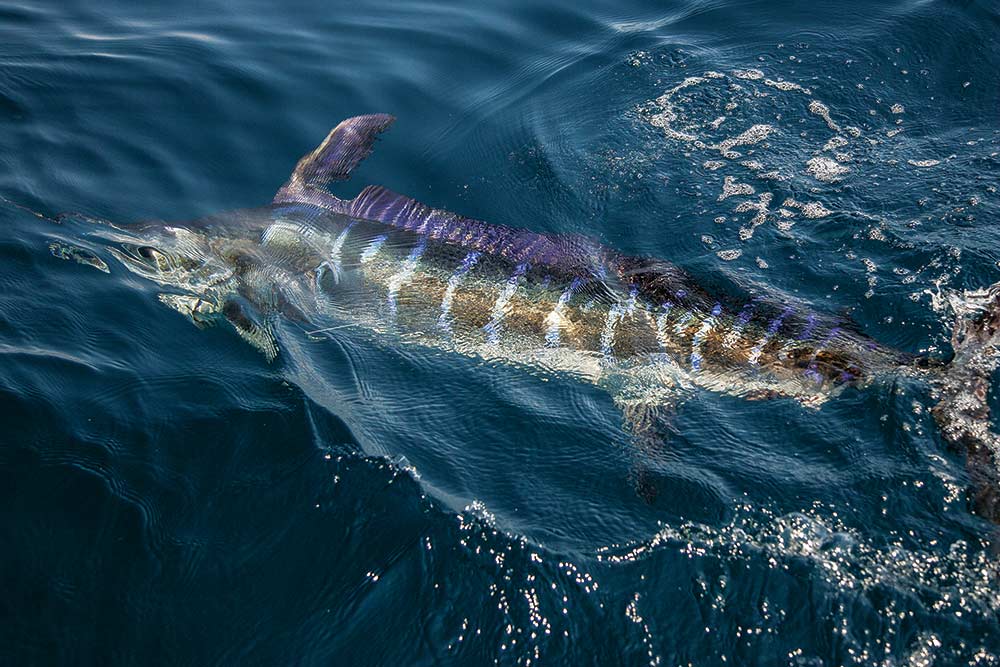
It wasn’t long before we had a couple nice tuna in the fish box, then one of the lines took a strange angle as it headed for the surface. “That’s no tuna,” I thought. Sure enough, a billfish erupted from the calm surface and put on a blazing display for the cameras, a real Hollywood fish. Upon closer examination, it was a striped marlin, and a nice one at that. Even more amazing, we had hooked the fish on a purple rubber-worm-and-jig combination that would have been more at home on Lake Okeechobee than in 5,000 feet of salt water off Costa Rica. (The mates have found that these rubber jigs work great on yellowfin tuna.) After a few more photos and video, we sent the striped marlin on its way.
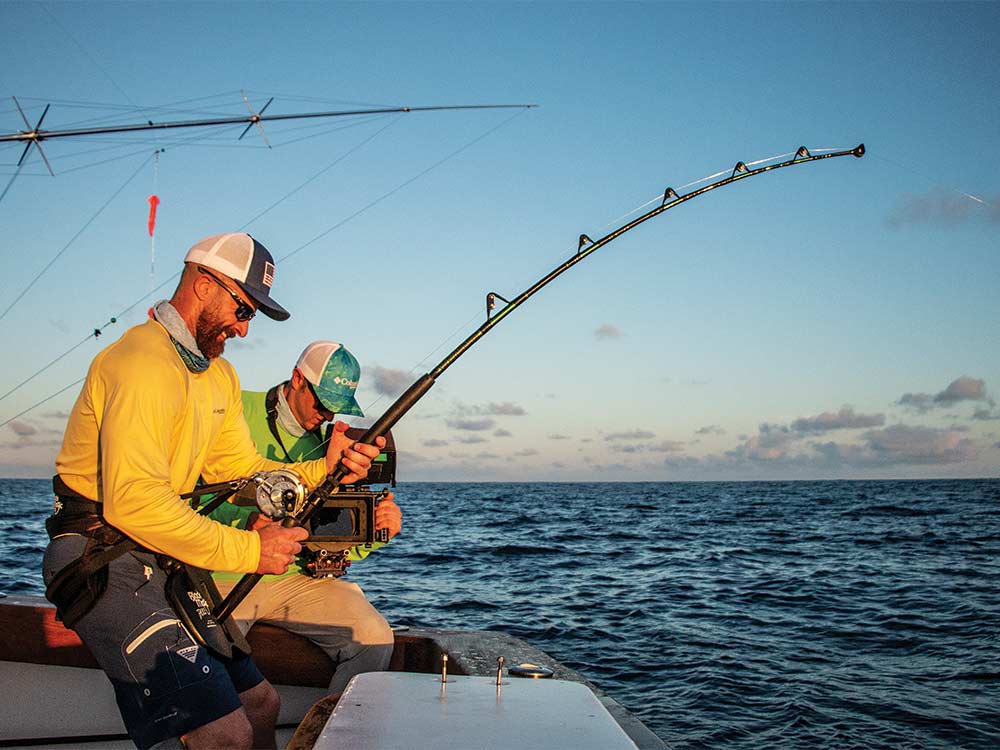
We released two blue marlin after the stripe, a couple chunky yellowfins and a half-dozen 30-pound dorado. We missed a couple more marlin as well, all on dead baits, dredges and 30-pound-test tackle. It was a blast, and all of this took place on seas that were as flat as your dining-room table. If there was one tiny disappointment, it was that we did not catch a sailfish for our boat grand slam. Costa Rica in December, and we did not raise a single sailfish the entire trip. Odd, but that’s fishing — and the marlin more than made up for it.
The next time you find yourself seeking a destination where exceptional fishing intersects with beautiful weather in a safe, welcoming country full of truly warm-hearted people, you’ll find it all and more in Quepos.
Quepos Confidential
Lodging: By far the most convenient and luxurious option for lodging are the Marina Pez Vela Villas, located just a short walk from the docks. There are 10 luxury villas available, with two- and three-bedroom options. Amenities include high-speed Wi-Fi, full kitchens and even a rooftop pool for the exclusive use of villa owners and guests. Our group stayed here during our trip. The luxury, decor, proximity to the docks and personalized concierge service make for an unforgettable and easy experience. The Hotel Parador, located on the edge of Manuel Antonio National Park, is another great option. It’s the official host for the Offshore World Championship.
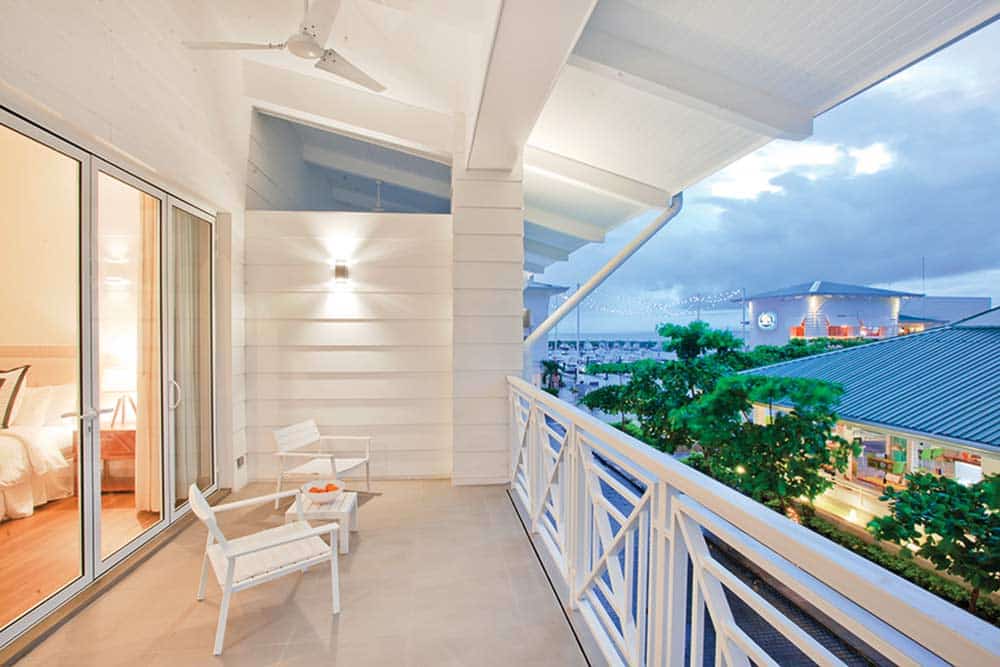
Dining: The Runaway Grill is the unofficial base of operations for anyone fishing out of Marina Pez Vela, with an extensive menu and happy-hour specials at the bar each afternoon. They also have a hook-and-cook policy where guests can bring in their own catch of the day and have it prepared that evening. We had several memorable meals at other restaurants in the marina as well, which run the gamut from fine dining to fast-casual sports pubs.
Fishing: Ken and Amanda Cofer have been chartering Tranquilo in Central America since 2012, relocating from Nicaragua to Costa Rica in 2014. “We wanted to offer a larger and nicer boat for people that wanted to experience a premier-level charter, with a great crew and all the latest equipment,” Amanda Cofer says. “Teams from the U.S. can come to Central America in their offseason to keep their anglers up to speed, and we offer them the same tackle, dredges and other gear they use on their own boats. We’re tournament-grade fishing every day, on every charter.” There are a host of additional charter operations based in Marina Pez Vela to fit nearly every species and budget. If time allows, don’t overlook the outstanding opportunities for roosterfish, cubera snapper, potential world-record snook and other species closer to shore.
Fishing the Offshore World Championship
The Offshore World Championship has been held in Quepos since 2013, thanks in large part to the support the event has received from Marina Pez Vela and the Costa Rica Tourism Board as well as the local community. According to OWC tournament director Dan Jacobs, Quepos is an optimal location for the event thanks to several key factors.
“The first is the weather,” he notes. “In April it’s nearly always flat-calm. And because the participating anglers rotate daily among the boats, the availability of a substantial charter fleet and a host facility large enough to accommodate everyone is also a critical element.” A plethora of hotels and restaurants check another must-have box.
Then there’s the fishing: Quepos has a world-class fishery, as noted in the OWC tournament records. In 2014, 64 teams video-verified 2,735 billfish releases; in 2015, 67 teams released 2,840 billfish, for an average of more than 42 billfish per team over four days of fishing. The OWC celebrates its 20th anniversary in 2019 with this year’s tournament running April 29 through May 3.




